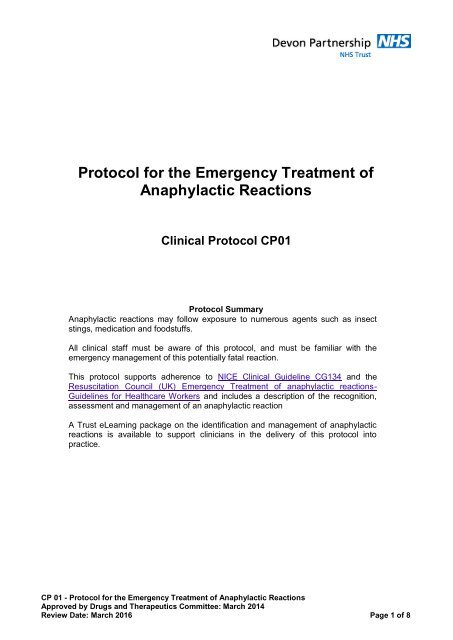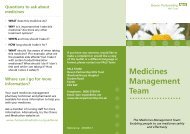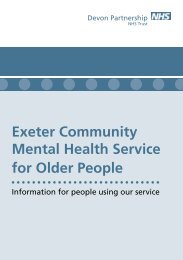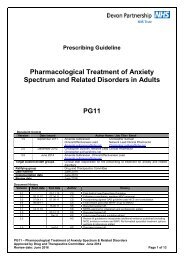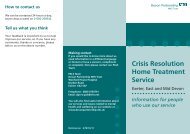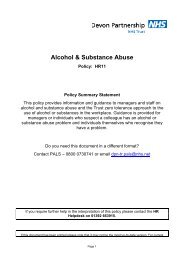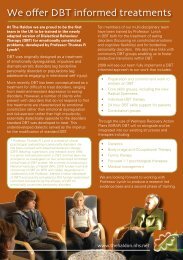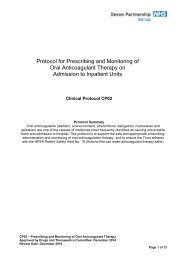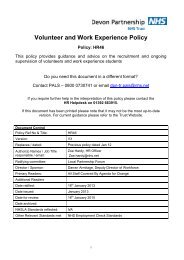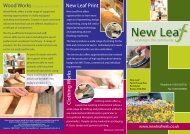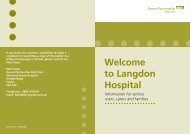CP01 Emergency Treatment of Anaphylactic Reactions - Devon ...
CP01 Emergency Treatment of Anaphylactic Reactions - Devon ...
CP01 Emergency Treatment of Anaphylactic Reactions - Devon ...
Create successful ePaper yourself
Turn your PDF publications into a flip-book with our unique Google optimized e-Paper software.
Protocol for the <strong>Emergency</strong> <strong>Treatment</strong> <strong>of</strong><br />
<strong>Anaphylactic</strong> <strong>Reactions</strong><br />
Clinical Protocol <strong>CP01</strong><br />
Protocol Summary<br />
<strong>Anaphylactic</strong> reactions may follow exposure to numerous agents such as insect<br />
stings, medication and foodstuffs.<br />
All clinical staff must be aware <strong>of</strong> this protocol, and must be familiar with the<br />
emergency management <strong>of</strong> this potentially fatal reaction.<br />
This protocol supports adherence to NICE Clinical Guideline CG134 and the<br />
Resuscitation Council (UK) <strong>Emergency</strong> <strong>Treatment</strong> <strong>of</strong> anaphylactic reactions-<br />
Guidelines for Healthcare Workers and includes a description <strong>of</strong> the recognition,<br />
assessment and management <strong>of</strong> an anaphylactic reaction<br />
A Trust eLearning package on the identification and management <strong>of</strong> anaphylactic<br />
reactions is available to support clinicians in the delivery <strong>of</strong> this protocol into<br />
practice.<br />
CP 01 - Protocol for the <strong>Emergency</strong> <strong>Treatment</strong> <strong>of</strong> <strong>Anaphylactic</strong> <strong>Reactions</strong><br />
Approved by Drugs and Therapeutics Committee: March 2014<br />
Review Date: March 2016 Page 1 <strong>of</strong> 8
Document Control<br />
Version Date Issued Author Name / Job Title / Email<br />
1.0 September 2009 Amanda Gulbranson<br />
Clinical Effectiveness Lead - Medicine Management<br />
amanda.gulbranson@nhs.net<br />
2.0 March 2011 Deborah Marriott<br />
Lead Clinical network Pharmacist (Exeter, East and Mid)<br />
Deborah.marriott@nhs.net<br />
Kelly Smith<br />
Prescribing Information Analyst<br />
Kelly.smith8@nhs.net<br />
3.0 May 2012 Amanda Gulbranson<br />
4.0 March 2013 Clinical Effectiveness Lead - Medicine Management<br />
5.0 March 2014 amanda.gulbranson@nhs.net<br />
Target audience / staff groups:<br />
Ratifying Group:<br />
Date ratified: March 2014<br />
Implementation date: March 2014<br />
Review date: March 2016<br />
Clinical staff: All inpatient units and staff responsible for the<br />
administration <strong>of</strong> vaccines<br />
Medicines Management Governance Group<br />
Document History<br />
Version Start End date Author History<br />
date<br />
1.0 September<br />
2009<br />
AG New Protocol signed <strong>of</strong>f. Replaces PGDs for adrenaline for<br />
treatment <strong>of</strong> anaphylaxis<br />
1.1 05.01.11 05.01.11 KS Added reference and hyperlink to Anaphylaxis eLearning<br />
package<br />
1.2 05.01.11 01.03.11 DM/KS Appendix 1 now includes the following:<br />
- To call 999<br />
- Record time adrenaline administered<br />
- Administer oxygen only if difficulty in breathing<br />
Add that Anaphylaxis pack to be stored in <strong>Treatment</strong> Room<br />
with other emergency equipment (not locked away).<br />
Add that the person should not be left alone until emergency<br />
services arrive.<br />
2.0 22.03.11 22.03.11 KS Document signed <strong>of</strong>f.<br />
2.1 May 12 AG Review <strong>of</strong> protocol to reflect Clinical Guidance issued by<br />
NICE (CG134) December 2011<br />
Sections 3.11, 4.2 bullet point 2 & 4.4 added<br />
3.0 May 12 KS Version 3 signed <strong>of</strong>f.<br />
3.1 Mar 13 21.03.13 AG Contents <strong>of</strong> anaphylactic packs reviewed<br />
Anaphylaxis pack to be stored in emergency Equipment bag<br />
Information contained in algorithm (Appendix 1) minimised.<br />
Section added regarding patient’s own adrenaline autoinjector<br />
devices.<br />
4.0 Apr13 KS Version 4 signed <strong>of</strong>f<br />
4.1 Feb14 Mar14 AG Anaphylaxis pack & contents reviewed in order to comply<br />
with EU Council Directive 2010/32/EU and availability <strong>of</strong><br />
500microgram adrenaline auto-injector device.<br />
5.0 Mar14 KS Document ratified at DTC and signed <strong>of</strong>f.<br />
CP 01 - Protocol for the <strong>Emergency</strong> <strong>Treatment</strong> <strong>of</strong> <strong>Anaphylactic</strong> <strong>Reactions</strong><br />
Approved by Drugs and Therapeutics Committee: March 2014<br />
Review Date: March 2016 Page 2 <strong>of</strong> 8
1. Introduction<br />
1.1 This protocol covers the recognition, assessment and treatment <strong>of</strong> anaphylactic reactions<br />
and is intended to be read in conjunction with the Resuscitation Council (UK) Guidelines for<br />
the <strong>Emergency</strong> <strong>Treatment</strong> <strong>of</strong> <strong>Anaphylactic</strong> <strong>Reactions</strong>.<br />
1.2 Anaphylaxis can be defined as ‘a severe, life-threatening, generalised or systemic<br />
hypersensitivity reaction’. Anaphylaxis is characterised by rapidly developing lifethreatening<br />
airway, breathing and /or circulation problems, usually associated with skin and<br />
mucosal changes.<br />
1.3 <strong>Anaphylactic</strong> reactions may follow exposure to a variety <strong>of</strong> agents, with insect stings, drugs<br />
(e.g. antibiotics, non-steroidal anti-inflammatory drugs, parenteral vitamins such as<br />
Pabrinex ® ) and some foods being the most common.<br />
Peanut and tree nut allergy now accounts for a significant incidence <strong>of</strong> anaphylaxis.<br />
Beta blockers may increase the severity <strong>of</strong> an anaphylactic reaction and antagonise the<br />
response to adrenaline (the decision to prescribe a beta-blocker to a patient at increased<br />
risk <strong>of</strong> an anaphylactic reaction should only be made after assessment by an allergist and<br />
cardiologist).<br />
1.4 A low rate <strong>of</strong> anaphylaxis has been observed following vaccination based on reports to the<br />
Vaccine Adverse Event Reporting System (VAERS) with an estimated incidence <strong>of</strong> 1 case in<br />
600,000 vaccine doses distributed. None <strong>of</strong> the reported cases were fatal, however<br />
anaphylaxis can be fatal and vaccinations can (in very rare instances) cause a lifethreatening<br />
hypersensitivity reaction in certain individuals. Further administration <strong>of</strong> vaccines<br />
or specific medication is contraindicated in people with a history <strong>of</strong> anaphylaxis after a<br />
previous dose<br />
1.5 The lack <strong>of</strong> any consistent clinical manifestation makes the diagnosis <strong>of</strong> anaphylaxis difficult.<br />
All clinicians who treat anaphylaxis should be aware <strong>of</strong> possible differential diagnoses (i.e.<br />
vasovagal attacks or panic attacks)<br />
2 <strong>Emergency</strong> Medication<br />
2.1 The following medication will be stocked for the emergency management <strong>of</strong> anaphylaxis in<br />
accordance with this protocol;<br />
o 3 x Adrenaline (1:1000) auto-injector<br />
devices (500micrograms/ 0.5mls)<br />
Brand may vary<br />
NB. Anti-histamines (chlorphenamine) and corticosteroids (hydrocortisone) NOT included. These are<br />
second-line treatments, and will be administered by paramedics or acute trust clinicians if indicated.<br />
2.2 <strong>Emergency</strong> medication for the management <strong>of</strong> anaphylaxis will be held as stock on<br />
All inpatient units<br />
Community teams where vaccination programmes are <strong>of</strong>fered (i.e. substance misuse<br />
services) and where individual workers administer vaccinations in the course <strong>of</strong> their<br />
work<br />
Note: Community psychiatric nurses solely administering antipsychotic depot injections need<br />
not carry an anaphylaxis treatment pack. Refer to section 4.3.2 <strong>of</strong> this document and Trust<br />
guidelines for the administration <strong>of</strong> antipsychotic depot injections.<br />
2.3 The emergency medication will be stored with the unit’s <strong>Emergency</strong> Resuscitation<br />
Equipment in the central (tamper-evident) section <strong>of</strong> the <strong>Emergency</strong> Equipment Bag (Fig<br />
1) OR on the Resuscitation/Crash team trolley (co-located wards only)<br />
CP 01 - Protocol for the <strong>Emergency</strong> <strong>Treatment</strong> <strong>of</strong> <strong>Anaphylactic</strong> <strong>Reactions</strong><br />
Approved by Drugs and Therapeutics Committee: March 2014<br />
Review Date: March 2016 Page 3 <strong>of</strong> 8
Fig. 1<br />
A flow chart for the emergency treatment <strong>of</strong> an anaphylactic<br />
reaction (Appendix 1) will be located in the front pocket <strong>of</strong> the bag.<br />
The pack must be easily accessible in an emergency- under no<br />
circumstances will the pack be locked away in a drug cupboard or<br />
trolley.<br />
The ward manager / clinical team leader is responsible for ensuring<br />
that all clinical staff are aware <strong>of</strong> the agreed location <strong>of</strong> the<br />
Anaphylaxis Pack on their ward / unit and all new staff must be<br />
informed <strong>of</strong> this on their first day <strong>of</strong> employment.<br />
2.4 The Resuscitation Link Practitioner (or other designated registered nurse) will be<br />
responsible for checking and recording the expiry date <strong>of</strong> the emergency medication held on<br />
the ward and ensure the timely reordering <strong>of</strong> replacement stock.<br />
Good Practice Recommendation:<br />
Record the expiry date <strong>of</strong> all emergency medication held on the ward next to the medicine listed on<br />
the ward stock pr<strong>of</strong>ile (<strong>Emergency</strong> Medication section).<br />
The registered nurse completing the weekly medication stock order will check the expiry date on<br />
the pr<strong>of</strong>ile and re-order if the expiry date less than 2 weeks from the current date.<br />
2.5 <strong>Emergency</strong> medication will be re-ordered as necessary from the pharmacy department in<br />
accordance with Standard Operating Procedure MM27 (Ordering ward stock from pr<strong>of</strong>iles)<br />
3. Patient’s Own Medication (Adrenaline auto-injector devices)<br />
3.1 Auto-injectors devices (e.g. Epipen ® ) are prescribed on an individual basis, by a specialist in<br />
allergy, for self- administration by people who are at risk <strong>of</strong> an anaphylactic reaction.<br />
3.2 If a person on an inpatient unit experiences an anaphylactic reaction, intramuscular<br />
adrenaline (500micrograms) will be administered in accordance with this protocol (see<br />
section 2.1 and Appendix 1). However, if access to the emergency medication is delayed, it<br />
would be appropriate for a healthcare pr<strong>of</strong>essional to use the person’s own adrenaline autoinjector<br />
(NB this may deliver a dose <strong>of</strong> 300miccrograms or 500micrograms depending on the<br />
product prescribed), for the management <strong>of</strong> an anaphylactic reaction to ensure timely<br />
administration <strong>of</strong> treatment.<br />
3.3 For individuals prescribed an adrenaline auto-injector by a specialist or their GP, the product<br />
should be prescribed in the ‘when required’ section <strong>of</strong> the Trust inpatient prescription and<br />
administration chart to ensure clinicians are aware the person is prescribed, and usually<br />
carries, emergency medication for self- treatment <strong>of</strong> an anaphylactic reaction.<br />
3.4 Individuals prescribed an adrenaline auto-injector should carry this with them during periods<br />
<strong>of</strong> leave away from the unit and staff must also ensure that the person’s own adrenaline<br />
auto-injector device is returned to them at the time <strong>of</strong> discharge. (Refer to procedure MM08)<br />
4. Recognition and diagnosis <strong>of</strong> anaphylaxis<br />
4.1 When recognising (and treating) any acutely ill patient, a rational ABCDE approach must be<br />
followed (see 4.2) and life-threatening problems treated as they are recognised.<br />
4.2 A diagnosis <strong>of</strong> anaphylaxis is likely if a patient who is exposed to a trigger (allergen) also<br />
presents with the following;<br />
• Sudden onset and rapid progression <strong>of</strong> symptoms<br />
• Life-threatening Airway and/or Breathing and/or Circulation problems<br />
• Skin and/or mucosal changes (flushing, urticaria, angioedema)<br />
CP 01 - Protocol for the <strong>Emergency</strong> <strong>Treatment</strong> <strong>of</strong> <strong>Anaphylactic</strong> <strong>Reactions</strong><br />
Approved by Drugs and Therapeutics Committee: March 2014<br />
Review Date: March 2016 Page 4 <strong>of</strong> 8
Presenting signs and symptoms may include;<br />
Airway<br />
Airway swelling (throat & tongue), difficulty breathing and swallowing, sensation <strong>of</strong><br />
throat closing up, hoarse voice, stridor (loud, harsh, high-pitched breathing)<br />
Breathing problems<br />
Shortness <strong>of</strong> breath (increased respiratory rate), wheeze, fatigue, confusion caused<br />
by hypoxia, cyanosis (blue-tinge to the skin), respiratory arrest.<br />
Some patients may die from acute irreversible asthma or laryngeal oedema with few<br />
more generalised manifestations present.<br />
Circulation<br />
Signs <strong>of</strong> shock (pale, clammy), tachycardia, hypotension, dizziness, collapse,<br />
reduced or loss <strong>of</strong> consciousness and faint carotid pulse.<br />
Disability<br />
Airway, breathing and circulatory problems can all alter neurological status causing<br />
confusion, agitation and loss <strong>of</strong> consciousness.<br />
Continued…..<br />
Exposure (Skin and/or mucosal changes)<br />
Urticaria can appear anywhere on the body. Wheals may be pale, pink or red and<br />
may look like a nettle sting. They can be different shapes & sizes, <strong>of</strong>ten surrounded<br />
by a red flare and usually itchy.<br />
Angioedema most commonly affects eyelids and lips and sometimes the mouth and<br />
throat.<br />
Skin or mucosal changes alone are not a sign <strong>of</strong> an anaphylactic reaction and can<br />
be subtle or absent in up to 20% <strong>of</strong> reactions.<br />
Other<br />
Gastrointestinal (vomiting, abdominal pain, incontinence), rhinitis and conjunctivitis.<br />
4.3 Differential Diagnosis:<br />
Non-life threatening conditions which can be confused with anaphylaxis include:<br />
4.3.1 Panic attacks<br />
Individuals who have previously experienced an anaphylactic reaction may be particularly<br />
prone to panic attacks if they think they have been re-exposed to the causative allergen.<br />
The sense <strong>of</strong> impending doom and breathlessness leading to hyperventilation may resemble<br />
anaphylaxis, however there is no hypotension, pallor, wheeze, or urticarial rash/swelling. An<br />
erythematous rash associated with anxiety may complicate diagnosis, whereas overbreathing,<br />
tingling around the lips and muscle spasms in the fingers are usually associated<br />
with panic attacks.<br />
4.3.2 Vasovagal Attacks<br />
Vasovagal attacks (vagal overactivity producing bradycardia and a fall in blood pressure)<br />
can occur following vaccination and administration <strong>of</strong> intra-muscular injections (i.e.<br />
antipsychotic depot injections) and can be misdiagnosed as anaphylaxis. However, the<br />
absence <strong>of</strong> rash, breathing difficulties, and swelling is a useful distinguishing feature as is<br />
the slow pulse and normal blood pressure (compared with the rapid pulse and<br />
low/undetectable blood pressure <strong>of</strong> a severe anaphylactic episode).<br />
5. <strong>Treatment</strong><br />
5.1 <strong>Treatment</strong> <strong>of</strong> an anaphylactic reaction should be based on general life support principals:<br />
Airway, Breathing, Circulation, Disability, and Exposure (ABCDE)<br />
5.2 In all cases <strong>of</strong> suspected anaphylactic reactions, immediately shout for assistance and an<br />
anaphylaxis pack. Medical help must be urgently sought by calling 999 from an outside line.<br />
5.3 The person should NOT be left unattended. From when the reaction is identified until the<br />
emergency services arrive, the person must not be left alone.<br />
CP 01 - Protocol for the <strong>Emergency</strong> <strong>Treatment</strong> <strong>of</strong> <strong>Anaphylactic</strong> <strong>Reactions</strong><br />
Approved by Drugs and Therapeutics Committee: March 2014<br />
Review Date: March 2016 Page 5 <strong>of</strong> 8
5.4 <strong>Treatment</strong> must not be delayed while waiting for an ambulance to arrive.<br />
5.5 Reassure the patient.<br />
5.6 Place the patient in a comfortable position taking into account the following factors:<br />
If the person has low blood pressure and / or reports feeling faint- lie the patient down<br />
flat, with or without leg elevation. If the person reports feeling faint, do not sit or stand<br />
them up (this can cause a cardiac arrest)<br />
A person with breathing difficulties may prefer to sit up to make breathing easier<br />
If the person is breathing but unconscious, place them on their side in the recovery<br />
position (NB pregnant patients should lie on their LEFT side to prevent caval<br />
compression).<br />
5.7 Remove the trigger allergen if possible (i.e. stop the administration <strong>of</strong> a medication, remove<br />
the stinger from a bee sting). If food is the suspected trigger, DO NOT attempt to induce<br />
vomiting. <strong>Treatment</strong> must NOT be delayed if the removal <strong>of</strong> the trigger is not feasible.<br />
5.8 Early administration <strong>of</strong> intramuscular adrenaline (epinephrine) is the treatment <strong>of</strong> choice in<br />
the management <strong>of</strong> anaphylactic shock.<br />
Use ADRENALINE (epinephrine) injection 1:1000 (1mg/ml)<br />
The dose for adults and children over 12 years is 500micrograms<br />
(0.5ml <strong>of</strong> Adrenaline 1:1000)<br />
Administer intramuscularly into the anterolateral aspect <strong>of</strong> the middle third <strong>of</strong> the thigh.<br />
(Refer to SOP MM28 Safer Use <strong>of</strong> Injectables)<br />
Administer the intramuscular injection with the needle at a 90º angle to the skin. The skin<br />
should be stretched not bunched<br />
Record the TIME that the dose was administered in the clinical notes<br />
In the absence <strong>of</strong> clinical improvement, repeat every 5 minutes (until paramedics arrive).<br />
For further information, consult a Summary <strong>of</strong> Product Characteristics for an adrenaline<br />
injection at www.medicines.org.uk/emc/<br />
5.9 Oxygen should be administered as soon as it is available. Oxygen should be administered<br />
using a mask with an oxygen reservoir using high flow oxygen (10 to15 litres/minute) to<br />
prevent the collapse <strong>of</strong> the reservoir during inspiration. (In life-threatening emergencies a<br />
prescription for oxygen is not necessary when acting in accordance with this protocol, but<br />
subsequently documented <strong>of</strong> treatment administered must be recorded).<br />
5.10 Patients who have been administered adrenaline (epinephrine) as first line treatment must<br />
be transferred to an acute Trust hospital as soon as possible where monitoring and further<br />
treatment (if appropriate) can be provided by paramedics and Accident and <strong>Emergency</strong><br />
clinicians.<br />
5.11 Clearly document the following information the patient’s electronic medical records:<br />
Presenting acute clinical features <strong>of</strong> suspected anaphylactic reaction<br />
The time <strong>of</strong> onset <strong>of</strong> the reaction<br />
The circumstances immediately before the onset <strong>of</strong> symptoms to help identify the<br />
possible trigger<br />
CP 01 - Protocol for the <strong>Emergency</strong> <strong>Treatment</strong> <strong>of</strong> <strong>Anaphylactic</strong> <strong>Reactions</strong><br />
Approved by Drugs and Therapeutics Committee: March 2014<br />
Review Date: March 2016 Page 6 <strong>of</strong> 8
6. Follow up<br />
6.1 Following an anaphylactic reaction all patients should be taken by ambulance to the accident<br />
and emergency (A&E) department <strong>of</strong> the local acute trust hospital for observation,<br />
assessment and further treatment where necessary. Individuals must be advised to go to<br />
A&E even where symptoms subside following immediate treatment, as delayed or rebound<br />
reactions may occur.<br />
6.2 Details <strong>of</strong> the incident should accompany the patient, to include:<br />
Probable cause <strong>of</strong> anaphylactic reaction (if known)<br />
Presenting clinical features <strong>of</strong> suspected anaphylactic reaction, time <strong>of</strong> onset and<br />
circumstances leading up to event ( as stated in 5.11)<br />
List <strong>of</strong> medications the patient is known to be taking, including over-the counter<br />
medicines and vitamin or mineral supplements if available.<br />
Action taken (i.e. doses <strong>of</strong> adrenaline given and the times <strong>of</strong> administration).<br />
6.3 All cases, where a medicine was suspected in causing an anaphylactic reaction, should be<br />
reported to the Medicines and Healthcare products Regulatory Agency (MHRA) using the<br />
Yellowcard ® system (found in the back <strong>of</strong> the BNF, or via the MHRA web-site:<br />
www.yellowcard.gov.uk).<br />
6.4 Following assessment and treatment by acute Trust emergency and / or medical services,<br />
ensure that details <strong>of</strong> any known / suspected allergies are updated in the patient’s medical<br />
records (and communicated to the GP on discharge) where applicable.<br />
7. Further Training<br />
7.1 There is an <strong>Anaphylactic</strong> Shock eLearning module available to promote the following:<br />
Recognition <strong>of</strong> anaphylaxis<br />
Common triggers <strong>of</strong> anaphylaxis<br />
Actions required if anaphylactic reaction occurs<br />
<strong>Treatment</strong> <strong>of</strong> anaphylaxis<br />
7.2 This module is required learning for all Trust clinical (nursing and medical) staff working on<br />
inpatient units, and for all clinical staff responsible for administering vaccines. The module<br />
must be completed once every year.<br />
7.3 Click here to access the module via the Trust’s Online Course Programme.<br />
8. References<br />
<strong>Emergency</strong> <strong>Treatment</strong> <strong>of</strong> <strong>Anaphylactic</strong> <strong>Reactions</strong>, Working Group <strong>of</strong> the Resuscitation<br />
Council (UK), January 2008<br />
Immunisation against infectious disease (The Green Book), Department <strong>of</strong> Health London<br />
HMSO, 2006<br />
British National Formulary Edition 57, British Medical Association and Royal Pharmaceutical<br />
Society <strong>of</strong> Great Britain, March 2009<br />
Should Community mental health nurses be trained in recognising and treating anaphylaxis,<br />
Mental Health Practice 2(10) 18-20, Paton C and Morrison P (1999)<br />
National Institute for Health and Clinical Excellence (2011) Clinical Guidelines CG134-<br />
Anaphylaxis<br />
CP 01 - Protocol for the <strong>Emergency</strong> <strong>Treatment</strong> <strong>of</strong> <strong>Anaphylactic</strong> <strong>Reactions</strong><br />
Approved by Drugs and Therapeutics Committee: March 2014<br />
Review Date: March 2016 Page 7 <strong>of</strong> 8
Appendix 1<br />
CP 01 - Protocol for the <strong>Emergency</strong> <strong>Treatment</strong> <strong>of</strong> <strong>Anaphylactic</strong> <strong>Reactions</strong><br />
Approved by Drugs and Therapeutics Committee: March 2014<br />
Review Date: March 2016 Page 8 <strong>of</strong> 8


